
Design and installation of the sewage of the private house with their own hands Useful advice

Construction of any home involves connecting different communications. One of them is a sewer system, without which it is difficult to present comfortable accommodation in the house. On the features of the installation of autonomous sewage, do it yourself and will be discussed in our article.
Content
Designing the sewer system in a private house
The main criterion for the sewage device is the amount of wastewater. This indicator depends on three factors:
- The number of permanent people.
- The amount of water consumes one person. Usually it is within 180-200 l per day per 1 tenant.
- The accumulation time of wastewater. Conditionally take 3 days, during which the decomposition of organic substances is carried out.
Thus, when designing and installing the sewage system of a private house, with their own hands, both the volume of selected effluents and recycled waste has been taken into account.
The amount of wastewater is determined by multiplying the above indicators. For example, 5 people constantly live in the house. In this case, the tank of 3 thousand liters will be needed for the sewer system. (5 people * 200 l. * 3 days).
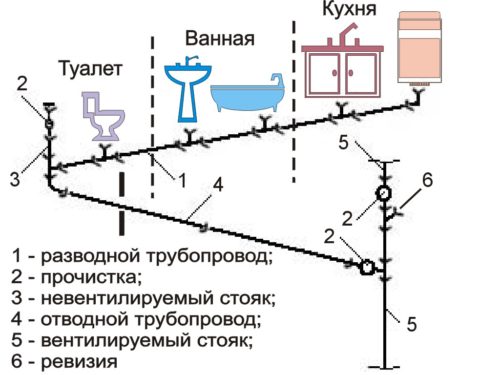
In addition to the amount of wastewater, it should be considered:
- sewage type (autonomous or connected with the central system);
- method of recycling (cesspool, hermetic drive, septic tank, biological station);
- the amount of precipitation in the region (when it is planned to create a storm sewage);
- geological features of the terrain (depth of freezing of soil and groundwater occurrence; the presence of water bodies, wells or wells; soil composition);
- the number of points from where the flow of water (washbasins, toilets, bathtubs, shower, dishwasher and washing machine) will be carried out.
The sewer system itself consists of two parts:
- internal;
- outdoor.
It is clear that when installing with your own seeding hands, the issue of the external system device disappears in the apartment. It will be enough to carry out internal sewage and crash into the general system of an apartment building.
The internal sewage device of the private house
This is the most complex and time-consuming part of the sewer system. Installation of internal sewage is carried out with their own hands, based on the location of the plumbing. And if there is a two-storey house, you will have to additionally engage in the installation of the sewer rim.
In order for the drainage system to work efficiently, a number of requirements should be observed:
- the toilet should be located near the riser;
- drain from the toilet is made separately;
- when using one riser, the entire plumbing is cut above the place where the stock is running from the toilet;
- the optimal length of the laid pipes in a separate section should not exceed 10 m;
- the presence of a small amount of turns;
- the longer the smooth section, the greater the diameter of the sewer pipe;
- the diameter of the pipes must exceed the diameter of the outlet plumbing holes;
- in the presence of too long pipe areas, auditing fittings are attached, with the help of which is cleaned from the crowding.
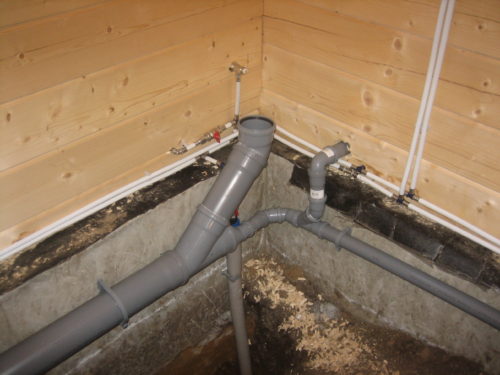
Laying of sewage pipes
Be sure to withstand the slope of pipes, which depends on their diameter:
- 0.8-1 cm / m - for pipes with a diameter of more than 15 cm;
- 2 cm / m - for pipes with a diameter of 8.5-11 cm;
- 3 cm / m - for pipes with a diameter of 4-5 cm.
When installing the pipes of the sewage, the type of plumbing is also taken into account:
- pipes with a diameter of 3-4 cm are used when washing and bidets;
- 4 cm - baths and shower;
- 6.5-7.5 cm - rims from the riser;
- 10 cm - central riser and toilet bowl.
Laying polypropylene pipes can be carried out both in the walls and in the floor. Subsequently, they can be coated with plaster (in the wall) and concrete solution (in the floor).
For pipe wiring used shaped connections:
- Knee. Designed for the design of the corners, where it is impossible to turn in 90º. In the corner, two knees should be used under 45º, which are connected to the pipes with seals with seals. This will lead to a decrease in hydraulic resistance and preventing the appearance of a blockage.
- Transitionans and tees. Applied when connecting pipes of pipes having the same dimensions.
- Couplings. Connect pipes of different thickness.
In the course of laying pipes, it is necessary to deal with the fact that they will need to be cut. For these purposes, you can use different tools. The perfect option is Truborez. But if it is not, then apply a hacksaw with small teeth, a sharp knife or a grinder.
After cutting:
- from the end part of the pipe, the chamofer is cut;
- pipe (for the length of the joint) is covered with silicone sealant;
- a sealing ring of rubber is stacked into the fuel;
- the pipe is inserted into the fool first until it stops, and then it takes out a little (it is ensured by heat gap).
For reliable fixation of pipes to the walls, clamps are used. The step of their mounting depends on the diameter of the pipe. The distance between adjacent clamps is equal to 10 pipe diameters. That is, when laying pipes with a diameter of 10 cm, clamps are placed at a distance of 1 m from each other.
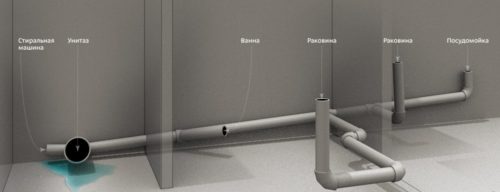
Naturally, the clamps are necessarily still attached in places connecting pipes. All joints must be dense, and the pipes are hard to fasten to the walls.
When installing the sewage, with your own hands, the pipe that connects the internal septic septication is equipped with a check valve. Its function is to prevent the water lift along the pipe in the event of a sewer system overflow.
Nuances setting a sewage setting of a private house
Special attention is paid to high-quality installation of the sewer riser:
- its upper part (fan tube) is placed at 0.5 m above the roof;
- the lower part is located below the first floor with outdoor access;
- dead-end risers that do not go to the roof are supplied with aeration valves;
- when erecting a large house, the number of risers increases to 2-3 units.
You can not remove the fan tube into the overall ventilation system. It will be the reason for the appearance of an unpleasant odor throughout the house. You can get rid of this problem only by replacing the new ventilation.
The installation itself of the internal sewage in the house with its own hands consists of such steps:
- installation of stands with an outcome of the ends in the basement and on the roof;
- sourding to the riser of the drain hole of the toilet;
- connection with a riser of another plumbing;
- installation of siphons.
Laying outdoor sewage
The main requirements for the sewage system outside the house:
- claimed facilities are located away from drinking wells, water bodies, perennial plantings, residential and economic buildings;
- the minimum tilt angle of pipes is 2 mm / 1 m;
- recommended line of highway - in a straight line;
- the presence of viewing wells every 50 meters;
- installation of septica or team well in the lowest point of the site.
The main issue when booking the outer sewer system is the choice of wastewater disposal in the absence of a centralized highway.
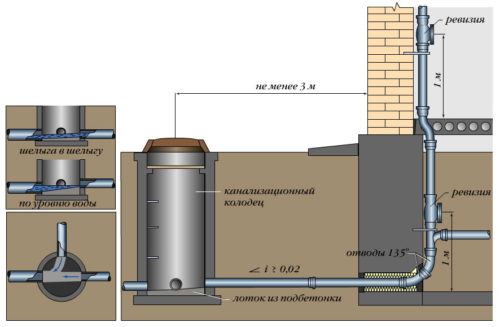
Celebration pit sewage
Not the best option for collecting a large amount of sewage drain. Especially if family members constantly enjoy the bathroom.
The cesspool device is advisable when the drains will be carried out only from the toilet bowl. In this case, the pipe is necessarily equipped with the check valve. It will prevent uncleanness to the house when the pit is filled with as much as possible.
Sealed sewage storage
It is a container in which wastewater from a bath, toilet and other plumbing. The hermetic drive is the cheapest option in the primary sewage installation in the house with your own hands.
But it requires constant pumping, which increases the cost of operation of the sewer system. For this reason, the hermetic drive is necessarily equipped with an audit hatch.
Septic sewage
The most common option in modern conditions. Septic is a hermetic reservoir, which on one side by the nozzle is connected to the inner sewer, with the other - the second nozzle displays purified water.
Septicch can be:
- single-section (the scope of sewage is 1-5 m³ / day);
- two-section (up to 10 m³ / day);
- three-section (over 10 m³ / day).
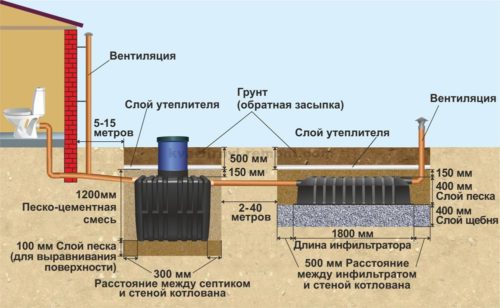
The action of the septicism consists in oxygen-free fermentation and the subsequent decomposition of organic substances to the sludge, gas and almost completely purified water (its final cleaning is carried out in perforated pipes for drainage).
Biological filtration station
Her principle of operation is similar to a septic. The only difference is for fermentation, bacteria and microorganisms are used, which are needed oxygen. Air supply is carried out using a compressor.
Undoubted dignity of the station - a high rate of decay of uncleanness, disadvantage - additional costs when using electrical energy
When installing the sewage in a private house, you can apply a combined method with your own hands. For example, wastewater from the washing machine and waste from the kitchen are sent to the drive and periodically exported. The rest of the septic tank is filled with other unclean. Such a separation is explained by the fact that detergents and powder negatively affect bacteria and microorganisms.
Mounting work
At the initial stage, earthworks are held. With new construction in the layout of the foundation, the corresponding holes for the sewer tube are made. The depth of pipe laying depends on the climatic features of the area. It usually is in the range of 0.8-1 m. The entrance to the septic must be at a depth of 1 m.
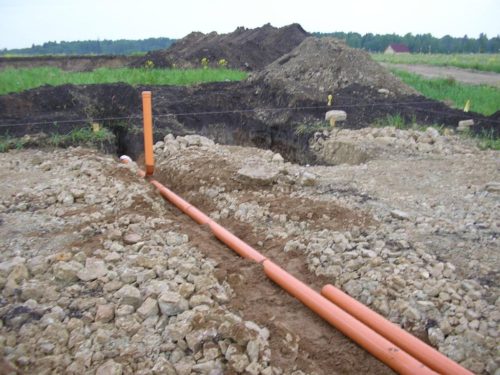
The process of creating external sewage consists of such steps:
- digging trenches with a slope to the placement of the septic;
- flooding the bottom of the trench with a 20-centimeter sand layer;
- sand seal;
- laying plastic pipes;
- reliable sealing of the junction of adjacent pipes;
- laying drainage pipes;
- pipe coating with sand and soil;
- tambrush soil.
It is worth noting that it is necessary to apply only pipes intended for sewage. It is also not recommended to use pipes from different parties. They may have different thermal expansion coefficients, which will cause their destruction.
The pipe connection is carried out with the creation of gaps between the socket and the pipe up to 1 cm in length. This is necessary in order to avoid damage as a result of the temperature expansion or soil pressure.
The place where the sewer pipe is included in the septic tank, reliably seal. For these purposes, you can use a rope that is soaked with solidol. In places of turns of pipes and every 25 m on a straight line, observation wells are mounted.
Video on the installation of sewage with your own hands:


















